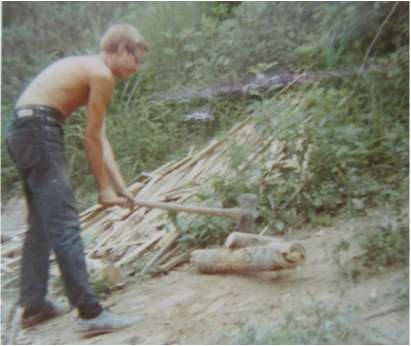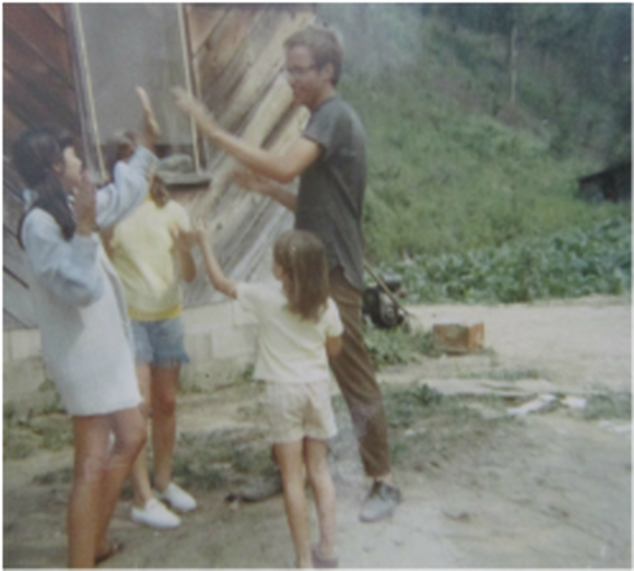|
Last Friday night Tom and I went to "Songs of Struggle," a commemoration of the Civil Rights Movement from 1960-1965 (See yesterday's post). We went with another couple, Kevin and Barb, who were friends of Tom's from college but you know how it goes after you're married, over the years your friends and my friends become our friends, right? Though Kevin and Barb live the next suburb over from us we managed to fall out of contact with them after all our children had grown up and it was only when Barb called out of the blue a few weeks ago that we reconnected. And so we invited them to go with us to "Songs of Struggle". To me it came to mind to invite Barb and Kevin to this particular event because I knew that in their day they, like my husband Tom, were part of the body of idealistic, service-minded young people who, coming of age in the half-generation following the early Civil Rights years, yearned to do some good in the world. Kevin, Barb and Tom found their opportunity while they were students at The University of Dayton in the late 1960's and early 1970's. The three met when they joined a campus service club called the Appalachia Club whose members traveled each weekend by van four hours from Dayton, Ohio to the mountains of Eastern Kentucky. At that time parts of Appalachia were plagued by extreme poverty and isolation. During their weekend trips the members of the Appalachia Club worked through an organization called Programs in Appalachia through Christian Effort, or PACE, rehabbing houses, offering arts and crafts classes for the local children, visiting families and experiencing life in the mountain hollers. Then in 1969 the Appalachia Club struck out on its own and moved from Floyd County to Magoffin County outside the town of Salyersville, Kentucky, and it was then that Tom and Kevin began scoping out the possibility of organizing a program for University of Dayton students to spend the summer volunteering in Magoffin County. The program began coming together when a Salyersville man offered to lend the students two houses he owned - or rather, two wooden structures - set back in an isolated holler called 22 Mile Branch for them to live in. As the UD Spring semester ended in April, in May 1970, a month before the 12 students who'd volunteered for that first summer program were to arrive, Tom and Kevin went down to 22 Mile Branch and spent the month making preparations. They laid groundwork in the surrounding community, set up schedules for the classes to be taught and the jobs to be done and spread the word among the local families. But they spent most of their time at 22 Mile Branch making the two structures they'd be living in habitable, one for the boys, one for the girls. Neither building had plumbing or electricity and there were some structural problems as well. All other water, for sponge baths, hand-washed laundry and cleaning, was pumped by hand from a well. When the group arrived such were their living conditions, but these young people dove into their work with enthusiasm and joy. Barb recalled how, though she herself had grown up with little beyond the basic necessities as one of ten children on a farm in Indiana, she'd never seen anything like the subsistence poverty of families living back in the hollers. "We set up a little pre-school-type experience for the children, fun, easy stuff, arts and crafts, a little reading. Like a little Head Start program. There was nothing like that for them at the time." They also ran a day camp, ...started a little league, and became part of the community. I asked Tom what they did for meals, having no refrigeration.
He told me that they'd received copious contributions of dry and canned goods: soup, peanut butter, crackers, spaghetti and sauce, cereal. He told me that every morning at "O Dark Thirty" he would get up and drive to Chester's, the small grocery store in Salyersville, for bacon, eggs, butter and milk for breakfast. Lunch was usually soup or something else from a can. Then at the end of the day Tom would swing by Chester's again for some meat for dinner. Anything perishable that they didn't use would have to be thrown out after each meal. Sometimes, though, families who had the means would invite the group - all twelve of them - over for a home-cooked meal. And so that first summer went, the UD Appalachia Club and the people of rural Magoffin County, Kentucky giving to and receiving from each other. Tom summed up that summer in one word: "Fantastic!" Once the school year began the UD Appalachia Club continued its weekend trips to Magoffin County and organized two more summer programs there before being told by the owner of the two houses at 22-Mile Branch that the houses would no longer be available for their use. But that wasn't the end of the club's program or its story. To be continued...
0 Comments
Leave a Reply. |
"Tropical Depression"
by Patti Liszkay Buy it on Amazon: https://www.amazon.com/dp/B0BTPN7NYY "Equal And Opposite Reactions"
by Patti Liszkay Buy it on Amazon: http://amzn.to/2xvcgRa or from The Book Loft of German Village, Columbus, Ohio Or check it out at the Columbus Metropolitan Library
Archives
July 2024
I am a traveler just visiting this planet and reporting various and sundry observations,
hopefully of interest to my fellow travelers. Categories |
























 RSS Feed
RSS Feed